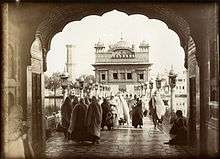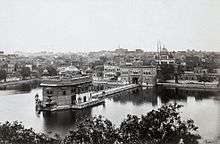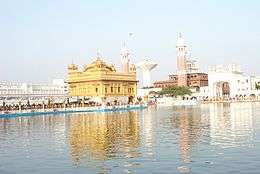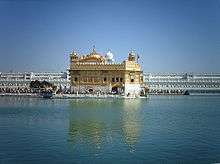Harmandir Sahib
| The Harmandir Sahib ਹਰਿਮੰਦਰ ਸਾਹਿਬ The Golden Temple | |
|---|---|
|
| |
| Alternative names | Darbar Sahib |
| General information | |
| Architectural style | Sikh architecture |
| Town or city | Amritsar |
| Country | India |
| Coordinates | 31°37′12″N 74°52′37″E / 31.62000°N 74.87694°ECoordinates: 31°37′12″N 74°52′37″E / 31.62000°N 74.87694°E |
| Construction started | December 1585 AD |
| Completed | August 1604 |
Harmandir Sahib (The abode of God) (Punjabi: ਹਰਿਮੰਦਰ ਸਾਹਿਬ), also Darbar Sahib (Punjabi: ਦਰਬਾਰ ਸਾਹਿਬ, Punjabi pronunciation: [dəɾbɑɾ sɑhɪb])[1] [3] and informally referred to as the "Golden Temple",[1] is the holiest Gurdwara of Sikhism, located in the city of Amritsar, Punjab, India. Amritsar (literally, the tank of nectar of immortality) was founded in 1574 by the fourth Sikh guru, Guru Ram Das.[4] The fifth Sikh Guru, Guru Arjan, designed the Harmandir Sahib to be built in the center of this holy tank, and upon its construction, installed the Adi Granth, the holy scripture of Sikhism, inside the Harmandir Sahib. [1]
The construction of Harmandir Sahib was intended to build a place of worship for men and women from all walks of life and all religions to come and worship God equally.[1][5] Accordingly, Guru Arjan had invited Muslim Sufi Saint, Sain Mian Mir to lay the foundation stone of the Harmandir Sahib. The four entrances (representing the four directions) to get into the Harmandir Sahib also symbolize the openness of the Sikhs towards all people and religions.[6] Over 100,000 people visit the holy shrine daily for worship, and also partake jointly in the free community kitchen and meal (Langar) regardless of any distinctions, a tradition that is a hallmark of all Sikh Gurudwaras. [7]
The present-day gurdwara was rebuilt in 1764 by Jassa Singh Ahluwalia with the help of other Sikh Misls. In the early nineteenth century, Maharaja Ranjit Singh secured the Punjab region from outside attack and covered the upper floors of the gurdwara with gold, which gives it its distinctive appearance and its English name.[8]
History


The Harmandir Sahib literally means the Temple of God. Guru Amar Das had ordered Guru Ram Das to create a nectarous tank as a place for worship for the Sikh religion. Guru Ram Das instructed all his Sikhs to join in the work, under Bhai Budha's superintendence, and engaged labourers to assist them. He said that the tank of nectar should be God's home, and whoever bathed in it shall obtain all spiritual and temporal advantages. During the progress of the work, the hut in which the Guru first sheltered himself was expanded for his residence; it is now known as the Guru's Mahal, or palace.[9]
In 1578 CE Guru Ram Das excavated a tank, which subsequently became known as Amritsar (Pool of the Nectar of Immortality),[10] giving its name to the city that grew around it. In due course, the Harmandir Sahib,[11] was built in the middle of this tank and became the supreme centre of Sikhism. Its sanctum came to house the Adi Granth comprising compositions of Sikh Gurus and other saints considered to have Sikh values and philosophies, e.g., Baba Farid, and Kabir. The compilation of the Adi Granth was started by the fifth guru of Sikhism, Guru Arjan.
Construction
Guru Arjan conceived the idea of creating a central place of worship for the Sikhs and designed the architecture of Harmandir Sahib. Earlier the planning to excavate the holy tank (Amritsar or Amrit Sarovar ) was chalked out by Guru Amar Das, the Third Sikh Guru, but it was executed by Guru Ram Das under the supervision of Baba Budha. The land for the site was acquired by the earlier Guru Sahibs on payment or free of cost from the Zamindars (landlords) of native villages. The plan to establish a town settlement was also made and the construction work on the Sarovar (the tank) and the town started simultaneously in 1570. The work on both projects was completed in 1577. In December 1588, Guru Arjan initiated the construction of the gurdwara and the foundation stone was laid by Hazrat Mian Mir on 28 December 1588.[12][13][14][14][15][16]
The gurdwara was completed in 1604. Guru Arjan installed the Guru Granth Sahib in it and appointed Baba Buddha as the first Granthi (reader) of it in August 1604. In the mid-18th century it was attacked by the Afghans, by one of Ahmed Shah Abdali's generals, Jahan Khan, and had to be substantially rebuilt in the 1760s. However, in response a Sikh Army was sent to hunt down the Afghan force. The forces met five miles outside Amritsar and Jahan Khan's army was destroyed.[17]
Operation Blue Star
Blue Star was a military operation undertaken between 3 June and 6 June 1984. The Indian prime minister Indira Gandhi ordered the Indian Army to launch the operation. The army, led by General Kuldip Singh Brar, willingly, brought infantry, artillery and tanks into the Harmandir Sahib to put a stop to the Dharam Yudh Morcha led by Jarnail Singh Bhindranwale. During the Dharam Yudh Morcha thousands of Sikhs courted arrest. Fierce fighting ensued between Sikhs and the army, with heavy casualties on both sides. The Harmandir Sahib complex also suffered much damage during the attack, especially the holy Akal Takht. Within six months, on 31 October 1984, Indira Gandhi's Sikh bodyguards killed her.
This attack is regarded by Sikhs, and the international human rights community, as a desecration of Sikhism's holiest shrine and discrimination against a minority in India. In 1986, the repairs performed on the Akal Takht Sahib after the attack, which the Rajiv Gandhi government had undertaken without consultation, were removed. A new Akal Takht Sahib was completed in 1999 by Kar Sevaks (volunteers).
Architectural features

Some of the architectural features of the Harmandir Sahib were intended to be symbolic of the Sikh world view.[18] Instead of the normal custom of building a gurdwara on high land, it was built at a lower level than the surrounding land so that devotees would have to go down steps to enter it.[18] In addition, instead of one entrance, Sri Harmandir Sahib has four entrances.[18]
The gurdwara is surrounded by the Sarovar, a large lake or holy tank, which consists of Amrit ("holy water" or "immortal nectar") and is fed by the Ravi River. There are four entrances to the gurdwara, signifying the importance of acceptance and openness. There are three holy trees (bers), each signifying a historical event or Sikh saint. Inside the gurdwara there are many memorial plaques that commemorate past Sikh historical events, saints and martyrs, including commemorative inscriptions of all the Sikh soldiers who died fighting in World War I and World War II.
Much of the present decorative gilding and marblework dates from the early 19th century. All the gold and exquisite marble work were conducted under the patronage of Hukam Singh Chimni and Emperor Ranjit Singh, Maharaja of the Sikh Empire of the Punjab. The Darshani Deorhi Arch stands at the beginning of the causeway to the Harmandir Sahib; it is 62 metres (203 ft) high and 6 metres (20 ft) in width. The gold plating on the Harmandir Sahib was begun by Ranjit Singh and was finished in 1830. Maharaja Ranjit Singh was a major donor of wealth and materials for the shrine.
Visiting
In keeping with the rule observed at all Sikh gurdwaras worldwide, the Harmandir Sahib is open to all persons regardless of their religion, colour, creed, or sex. The only restrictions on the Harmandir Sahib's visitors concern their behaviour when entering and while visiting:
- Maintaining the purity of the sacred space and of one's body while in it:
- Upon entering the premises, removing one's shoes (leaving them off for the duration of one's visit) and washing one's feet in the small pool of water provided;
- Not drinking alcohol, eating meat, or smoking cigarettes or other drugs while in the shrine
- Dressing appropriately:
- Wearing a head covering (a sign of respect) (the gurdwara provides head scarves for visitors who have not brought a suitable covering);[19]
- Not wearing shoes (see above).
- How to act:
- When listening to Gurbani, one must also sit on the ground while in the Darbar Sahib as a sign of deference to both the Guru Granth Sahib and God.
First-time visitors are advised to begin their visit at the information office and then proceed to the Central Sikh Museum near the main entrance and clock tower.
The Harimandir Sahib runs one of the largest free kitchens in the world, serving 100,000 people on average daily. The meal consists of flat bread and lentil soup.[20]
Celebrations
One of the most important festivals is Vaisakhi, which is celebrated in the second week of April (usually the 13th). Sikhs celebrate the founding of the Khalsa on this day and it is celebrated with fervour in the Harmandir Sahib. Other important Sikh religious days such as the birth of Guru Ram Das, martyrdom day of Guru Teg Bahadur, the birthday of the Sikh founder Guru Nanak, etc., are also celebrated with religious piety. Similarly Diwali is one of the festivals which sees the Harmandir Sahib beautifully illuminated with Diyas (lamps); lights and fireworks are discharged. Most Sikhs visit Amritsar and the Harmandir Sahib at least once during their lifetime, particularly and mostly during special occasions in their life such as birthdays, marriages, childbirth, etc.
Photo gallery


-

Nishaan Sahib (Flagstaffs)
-

The Harmandir Sahib Complex
-

Harmandir Sahib Amritsar 1987, Amritsar.
-

Panorama of the main building and Sarovar
-

North Entrance gate near Ath-sath Tirath (68 Sacred Places)
-

Causeway to the Harmandir Sahib
-

Wide-angle view of the Harmandir Sahib
-
Langar Canteen, inside the Harmandir Sahib
-

The Harmandir Sahib
-

Ber Baba Buddha Ji
-

Fish in Amrit
-
Golden Temple side view in day light
-
Harmandir Sahib Temple Punjab
-

Girl at the temple in traditional clothing
-

Dukh Bhanjani Beri & Ath Sath Tirath
-
_in_Amritsar%2C_India.jpg)
Sikh pilgrim at the Harmandir Sahib. The man hasj ust had a bath in the sarovar (pool of nectar). "The sacred waters of sarovars are considered to have curative properties because of the continual prayers of Sikh scripture recited in the vicinity." [1]
-
.jpg)
The Harmandir Sahib main building with Akal Takht Sahib
-

Akal Takht and Harmandir Sahib, Amritsar.
-

Entrance to the Harmandir Sahib as seen from the inside of the complex
See also
References
- 1 2 3 4 5 Kerr, Ian J. "Harimandar". Encyclopaedia of Sikhism. Punjabi University Patiala. Retrieved 21 March 2015.
- ↑ "Sikhism Religion of the Sikh People". sikhs.org.
- ↑ Golden Temple, Punjabi University, Parm Barkshish Singh, Devinder Kumar Verma, ISBN 978-81-7380-569-1
- ↑ "History, Harmandir Sahib, the Golden Temple, Amritsar". Amritsar Portal. Retrieved 29 November 2014.
- ↑ "Sikhism Religion of the Sikh People". sikhs.org.
- ↑ Fahlbusch, Erwin; Geoffrey William Bromiley (1999). The encyclopedia of Christianity (Reprint ed.). Leiden: Brill. ISBN 978-90-04-14596-2.
- ↑ "Soon, Golden Temple to use phone jammers. Over Two lakh people visit the holy shrine per day for worship. In festivals over six lakh to eight lakh visit the holy shrine.". The Times Of India. 19 July 2012.
- ↑ Hew McLeod (1997). Sikhism. New York: Penguin Books. pp. 154â161. ISBN 0-14-025260-6. C1 control character in
|pages=at position 5 (help) - ↑ Max Arthur Macauliffe. 1909. The Sikh Religion.. Vol. II
- ↑ Golden Temple, Punjabi University, Parm Barkshish Singh, Devinder Kumar Verma ISBN 978-81-7380-569-1
- ↑ Golden Temple, Punjabi University, Parm Barkshish Singh, Devinder Kumar Verma, ISBN 978-81-7380-569-1.
- ↑ Dr. Madanjit Kaur “The Golden Temple: Past and Present" Dept. of Guru Nanak Studies, Guru Nanak Dev University Press, 1983, p. 11
- ↑ Kavi Santokh Singh : "Gurprataap Sooraj Granth" Ras 2, Ansu 53: ਇਮਿ ਅਰਦਾਸ ਕਰੀ ਬ੍ਰਿਧ ਜਬੈ। ਸ਼੍ਰੀ ਅਰਜਨ ਕਰ ਪੰਕਜ ਤਬੈ ॥੧੩॥ ਗਹੀ ਈਂਟ ਤਹਿਂ ਕਰੀ ਟਿਕਾਵਨ। ਮੰਦਰ ਅਵਿਚਲ ਨੀਵ ਰਖਾਵਨ।, p. 428 in PDF ebook
- 1 2 "Gurdwara Sahib, Tapoban". tapoban.org.
- ↑ Teja Singh & Ganda Singh, A Short History of the Sikhs, vol. 1, p. 28.
- ↑ Max Arthur Macauliffe, The Sikh Religion, vol. 3, p. 10
- ↑ Volume 2: Evolution of Sikh Confederacies (1708–1769), By Ram Gupta.
- 1 2 3 Singh, Khushwant (1991). A history of the Sikhs: Vol. 1. 1469–1839. Oxford University Press. p. 53. Retrieved 18 December 2011.
- ↑ "Postcards from Amritsar -". elenastravelgram.com.
- ↑ Shafi, Showkat (17 November 2013). "Kitchen that feeds 100,000 daily". Al Jazeera. Retrieved 3 January 2014.
External links
| Wikimedia Commons has media related to Harmandir Sahib. |
- Official website
- Website of Shiromani Gurdwara Parbandhak Committee
- Official iPhone application
- Harmandir Sahib at DMOZ
| ||||||||||||||||||||||||||||||||||
